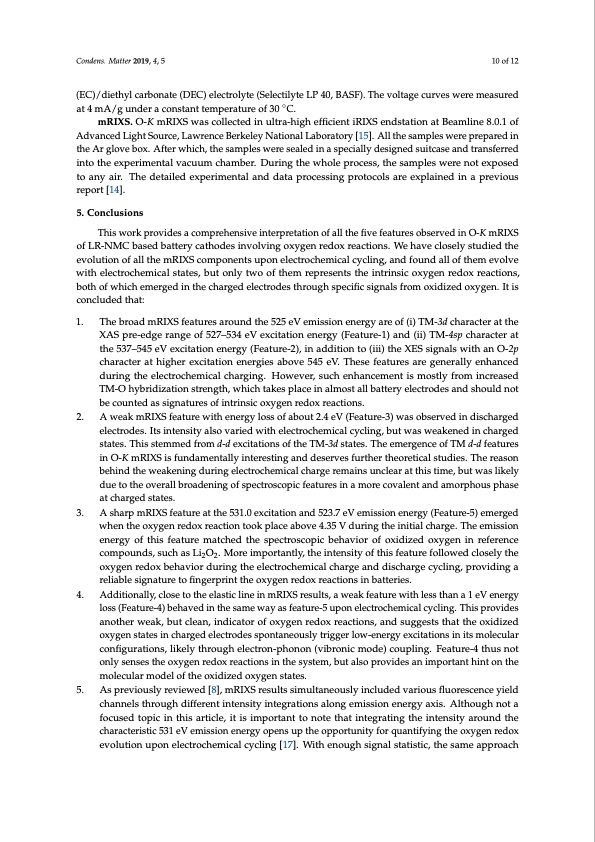
PDF Publication Title:
Text from PDF Page: 010
Condens. Matter 2019, 4, 5 10 of 12 (EC)/diethyl carbonate (DEC) electrolyte (Selectilyte LP 40, BASF). The voltage curves were measured at 4 mA/g under a constant temperature of 30 ◦C. mRIXS. O-K mRIXS was collected in ultra-high efficient iRIXS endstation at Beamline 8.0.1 of Advanced Light Source, Lawrence Berkeley National Laboratory [15]. All the samples were prepared in the Ar glove box. After which, the samples were sealed in a specially designed suitcase and transferred into the experimental vacuum chamber. During the whole process, the samples were not exposed to any air. The detailed experimental and data processing protocols are explained in a previous report [14]. 5. Conclusions This work provides a comprehensive interpretation of all the five features observed in O-K mRIXS of LR-NMC based battery cathodes involving oxygen redox reactions. We have closely studied the evolution of all the mRIXS components upon electrochemical cycling, and found all of them evolve with electrochemical states, but only two of them represents the intrinsic oxygen redox reactions, both of which emerged in the charged electrodes through specific signals from oxidized oxygen. It is concluded that: 1. The broad mRIXS features around the 525 eV emission energy are of (i) TM-3d character at the XAS pre-edge range of 527–534 eV excitation energy (Feature-1) and (ii) TM-4sp character at the 537–545 eV excitation energy (Feature-2), in addition to (iii) the XES signals with an O-2p character at higher excitation energies above 545 eV. These features are generally enhanced during the electrochemical charging. However, such enhancement is mostly from increased TM-O hybridization strength, which takes place in almost all battery electrodes and should not be counted as signatures of intrinsic oxygen redox reactions. 2. A weak mRIXS feature with energy loss of about 2.4 eV (Feature-3) was observed in discharged electrodes. Its intensity also varied with electrochemical cycling, but was weakened in charged states. This stemmed from d-d excitations of the TM-3d states. The emergence of TM d-d features in O-K mRIXS is fundamentally interesting and deserves further theoretical studies. The reason behind the weakening during electrochemical charge remains unclear at this time, but was likely due to the overall broadening of spectroscopic features in a more covalent and amorphous phase at charged states. 3. A sharp mRIXS feature at the 531.0 excitation and 523.7 eV emission energy (Feature-5) emerged when the oxygen redox reaction took place above 4.35 V during the initial charge. The emission energy of this feature matched the spectroscopic behavior of oxidized oxygen in reference compounds, such as Li2O2. More importantly, the intensity of this feature followed closely the oxygen redox behavior during the electrochemical charge and discharge cycling, providing a reliable signature to fingerprint the oxygen redox reactions in batteries. 4. Additionally, close to the elastic line in mRIXS results, a weak feature with less than a 1 eV energy loss (Feature-4) behaved in the same way as feature-5 upon electrochemical cycling. This provides another weak, but clean, indicator of oxygen redox reactions, and suggests that the oxidized oxygen states in charged electrodes spontaneously trigger low-energy excitations in its molecular configurations, likely through electron-phonon (vibronic mode) coupling. Feature-4 thus not only senses the oxygen redox reactions in the system, but also provides an important hint on the molecular model of the oxidized oxygen states. 5. As previously reviewed [8], mRIXS results simultaneously included various fluorescence yield channels through different intensity integrations along emission energy axis. Although not a focused topic in this article, it is important to note that integrating the intensity around the characteristic 531 eV emission energy opens up the opportunity for quantifying the oxygen redox evolution upon electrochemical cycling [17]. With enough signal statistic, the same approachPDF Image | Oxygen Redox Reactions in Batteries Resonant Inelastic X-ray Scattering

PDF Search Title:
Oxygen Redox Reactions in Batteries Resonant Inelastic X-ray ScatteringOriginal File Name Searched:
condensedmatter-04-00005.pdfDIY PDF Search: Google It | Yahoo | Bing
Sulfur Deposition on Carbon Nanofibers using Supercritical CO2 Sulfur Deposition on Carbon Nanofibers using Supercritical CO2. Gamma sulfur also known as mother of pearl sulfur and nacreous sulfur... More Info
CO2 Organic Rankine Cycle Experimenter Platform The supercritical CO2 phase change system is both a heat pump and organic rankine cycle which can be used for those purposes and as a supercritical extractor for advanced subcritical and supercritical extraction technology. Uses include producing nanoparticles, precious metal CO2 extraction, lithium battery recycling, and other applications... More Info
| CONTACT TEL: 608-238-6001 Email: greg@infinityturbine.com | RSS | AMP |